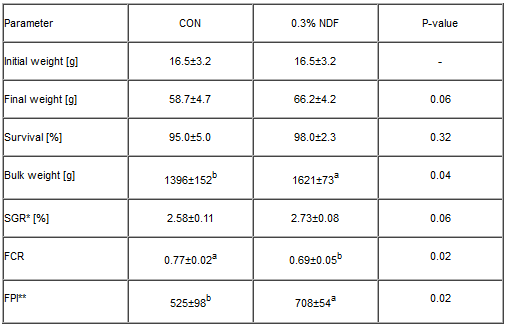Organic acids and their salts are seen as an alternative to using antibiotics as growth promoters (Lückstädt (2006), but their use in aquaculture is comparatively new compared to livestock and poultry feeds. Research in Atlantic salmon Salmo salar showed the beneficial effect of potassium diformate (KDF) on performance parameters (Christiansen and Lückstädt, 2008). Studies with hybrid tilapia have shown that fish given 0.3 and 0.6% KDF had significantly better growth than those given antibiotics (Zhou et al, 2009). This was confirmed by Cuvin-Aralar et al. (2010) who showed significantly better growth, growth rate and FCR in juvenile Nile tilapia given diets supplemented with 0.3% KDF compared to control diets. Limited data are available as to the effect of sodium diformate (NDF) on growth and FCR in Nile tilapia.
Material and Methods
Twenty-five male Nile tilapia (mean weight 16.5 ± 3.2 g) were stocked in each of eight 240 l polyethylene tanks in a static-renewal system. The fish in four randomly selected tanks were given commercially formulated feed (CON) while the others received commercially formulated diets supplemented with 0.3% sodium diformate (NDF). Fish in both the CONTROL and NDF treatment were fed a daily ration equivalent to 5% of their body weight for the first two weeks; reduced to 3% until the sixth week and 2% until the end of the feeding trial. Feed was dispensed three times a day at 0800, 1200, 1600h. The fish were weighed every week to monitor growth and adjust feed ration. Eighty percent of the water was changed every 3 days, an hour after the morning ration was dispensed. Water quality (dissolved oxygen, temperature, pH and ammonia) was monitored prior to water replacement. The experimental ran for 78 days. Analysis of Variance using SAS (Cary, NC, USA) was used for statistical analyses with P<0.05.
Results
Water quality parameters were within the acceptable range for Nile tilapia growth. Mean dissolved oxygen was 6.1±0.4 mg l-1, temperature was 29.1±3.5, pH was 6.7±0.9 and ammonia (NH3-N) was
Table I: Production Parameters of Nile Tilapia After 78 Days of Rearing with or without Sodium Diformate

*SGR = Specific Growth Rate: (ln Final weight [g] - ln Initial weight [g]) / culture period [d] × 100
**FPI = Fish Productivity Index: Weight gain [g] × Survival [%] / (FCR × 10)
Discussion
Addition of 0.3% NDF in the diets of Nile tilapia improved growth and other production parameters significantly. These findings are in line with several other studies testing the effect of diformates in tilapia (Zhou et al, 2009; Cuvin-Aralar et al, 2010). To date, there has been only speculation on the mode of action of organic acid compounds in fish. Liebert et al. (2010) reported improved digestibility, especially of protein. Ng et al. (2009) found significantly reduced fecal bacteria counts in organic acid supplemented fish and similar trends were also observed in gut microflora. These may be among the reasons for improved growth. In terrestrial animals, reduced energy use from the gut microflora has energy sparing effects of up to 6% of the dietary net energy (Jensen, 1998). Organic acids, and especially sodium diformate, are therefore an interesting option to improve performance in tilapia.
April 2013




